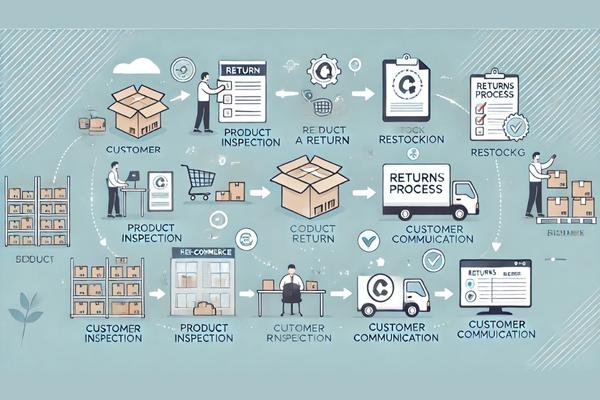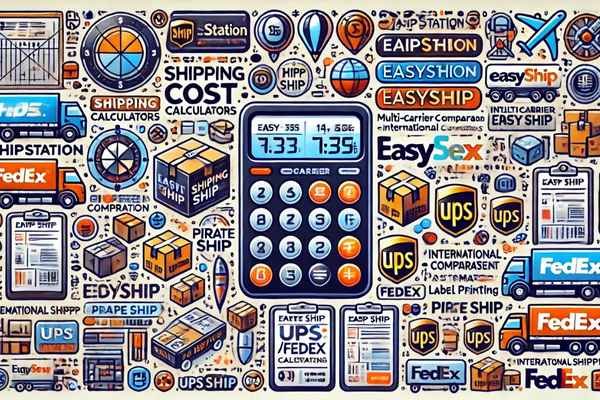
How to Optimize Your E-commerce Business with Inventory Management Tools
October 2, 2024
Best Software for Automating Inventory Control in 2025
October 2, 2024Effective inventory management is a cornerstone for any business, particularly in e-commerce and retail sectors. Automation tools that manage stock levels can help businesses save time, reduce human error, and improve overall efficiency. In this article, we’ll explore the top 5 inventory management tools for automating stock control, giving you insights into how these systems can streamline your business operations.
Table of Contents
1. Why Inventory Management Automation Matters
The Role of Automation in Modern Inventory Management
Inventory management involves tracking and managing stock across multiple channels, whether in a warehouse, retail location, or e-commerce store. With the rise of e-commerce and multi-channel selling, manual inventory tracking has become inefficient and error-prone. Automated inventory management software simplifies the process by offering real-time tracking, low-stock alerts, and seamless integration with sales platforms.
Benefits of Automation in Inventory Control:
- Reduced Errors: Automation minimizes mistakes in stock counts and reordering.
- Time Savings: Automation frees up valuable time for business owners and managers to focus on growth.
- Data Insights: Advanced tools provide detailed analytics that help businesses make informed decisions.
2. How to Choose the Best Inventory Management Tool
Consider Your Business Needs
When selecting inventory management software, consider the size of your business, the number of sales channels, and the level of complexity in your supply chain. Some solutions are tailored for small businesses, while others serve large enterprises with complex requirements.
Key Features to Look for in Inventory Management Software
- Real-time stock updates
- Low-stock notifications
- Multi-channel integration (e.g., Amazon, Shopify, eBay)
- Customizable reports and analytics
- Mobile access for inventory tracking on the go
3. Top 5 Inventory Management Tools for Automating Stock Control
3.1. TradeGecko (now QuickBooks Commerce)
Overview:
QuickBooks Commerce, formerly known as TradeGecko, is a cloud-based platform that helps businesses manage inventory, orders, and supply chains across multiple sales channels. It integrates seamlessly with accounting software like QuickBooks, making it an all-in-one solution for small and medium-sized businesses.
Key Features:
- Multi-channel inventory synchronization
- Automated reordering and purchase orders
- Integration with e-commerce platforms like Shopify and WooCommerce
- Detailed sales analytics and reporting
Why Use QuickBooks Commerce?
QuickBooks Commerce offers an excellent balance of features and pricing, making it ideal for small to mid-sized businesses looking to streamline operations.
Affiliate Link: Explore QuickBooks Commerce
3.2. NetSuite ERP
Overview:
NetSuite ERP is a comprehensive enterprise resource planning (ERP) software that offers powerful inventory management features. It is ideal for larger businesses with complex supply chains and multi-location warehouses. NetSuite’s advanced features include demand planning, warehouse management, and automated replenishment.
Key Features:
- Multi-location inventory management
- Demand forecasting and planning tools
- Automated reorder points and stock alerts
- Integration with CRM and e-commerce systems
Why Use NetSuite ERP?
NetSuite is perfect for large enterprises seeking a robust system that can handle complex supply chains, multiple warehouses, and global operations.
Affiliate Link: Explore NetSuite ERP
3.3. Zoho Inventory
Overview:
Zoho Inventory is a powerful yet affordable solution for small businesses that need inventory tracking, order management, and multi-channel sales integration. With Zoho, businesses can automate repetitive tasks such as creating purchase orders and sending low-stock alerts, freeing up time for growth-oriented activities.
Key Features:
- Multi-channel inventory synchronization
- Real-time order tracking
- Automated workflows for reordering
- Integration with Zoho’s suite of business tools
Why Use Zoho Inventory?
Zoho is ideal for small businesses and startups looking for an affordable and scalable inventory management solution.
Affiliate Link: Explore Zoho Inventory
3.4. Cin7
Overview:
Cin7 is a cloud-based inventory management platform tailored for businesses that operate across multiple sales channels, including online stores, retail outlets, and B2B operations. Cin7 excels in automation and integration, allowing businesses to automate stock control, order processing, and inventory reporting.
Key Features:
- Automated inventory control and reordering
- Integration with over 100 third-party platforms (e.g., Shopify, Amazon)
- Customizable reports and dashboards
- Mobile app for on-the-go inventory management
Why Use Cin7?
Cin7 is perfect for businesses seeking advanced automation and integration capabilities for multi-channel selling.
Affiliate Link: Explore Cin7
3.5. Veeqo
Overview:
Veeqo is an inventory management tool designed for e-commerce businesses. It allows for the centralization of stock management across multiple sales channels, including Amazon, eBay, and Shopify. Veeqo also offers shipping automation, making it a comprehensive solution for e-commerce businesses.
Key Features:
- Real-time inventory tracking across all channels
- Bulk shipping label printing and automation
- Integration with e-commerce platforms and marketplaces
- Stock forecasting and automated reorder points
Why Use Veeqo?
Veeqo is an excellent choice for e-commerce businesses that need to automate stock control and streamline their shipping processes.
Affiliate Link: Explore Veeqo
Top 5 Inventory Management Tools for Automating Stock Control Comparaison
| Tool | Key Features | Best For | Pricing | Visit |
|---|---|---|---|---|
| QuickBooks Commerce | Multi-channel sync, automated reordering, detailed analytics | Small to mid-sized businesses | Starts at $39/month | Explore QuickBooks Commerce |
| NetSuite ERP | Demand planning, multi-location management, advanced automation | Large enterprises | Custom pricing | Explore NetSuite ERP |
| Zoho Inventory | Real-time tracking, order management, multi-channel integration | Small businesses | Free plan; paid plans from $59/month | Explore Zoho Inventory |
| Cin7 | Omnichannel automation, B2B features, integration with 100+ platforms | Growing e-commerce businesses | Starts at $299/month | Explore Cin7 |
| Veeqo | Real-time updates, shipping automation, stock forecasting | E-commerce businesses | Custom pricing | Explore Veeqo |
4. Frequently Asked Questions
What is the best inventory management software for small businesses?
Zoho Inventory is one of the best options for small businesses due to its affordability, ease of use, and robust feature set. It offers automation for inventory tracking and integrates seamlessly with major e-commerce platforms.
Can inventory management software help reduce stock discrepancies?
Yes, inventory management software with real-time tracking, automated stock updates, and low-stock alerts can significantly reduce discrepancies caused by human error, lost inventory, or over-ordering.
What features should I look for in inventory management software?
Key features include real-time inventory updates, multi-channel integration, low-stock alerts, automated reordering, and customizable reporting. Additionally, mobile access and integration with accounting tools can improve overall efficiency.
Conclusion
Choosing the right inventory management software depends on your business size, industry, and specific needs. The tools mentioned above—QuickBooks Commerce, NetSuite ERP, Zoho Inventory, Cin7, and Veeqo—offer varying levels of automation and integration, making them suitable for different types of businesses. Whether you’re a small business owner or manage a large enterprise, automating your stock control can save time, reduce errors, and improve profitability.








